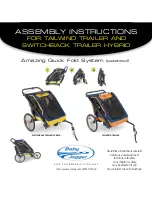
The Basics
WARNING: It is your responsibility to
familiarize yourself with the laws
where you ride and to comply with all
applicable laws, including properly
equipping yourself and your bike as the law
requires.
Observe all local bicycle laws and regulations.
Observe regulations about bicycle lighting,
licensing of bicycles, riding on sidewalks, laws
regulating bike path and trail use, helmet laws,
child carrier laws, and special bicycle traffic
laws. It’s your responsibility to know and obey
your country’s laws.
Always do check the safety of your bike
•
before you ride it.
Be thoroughly familiar with the controls of
•
your bicycle: brakes (Section 4.B); pedals
(Section G); shifting (Section 4.C).
Be careful to keep body parts and other
•
objects away from the sharp teeth of chain
rings, the moving chain, the turning pedals
and cranks, and the spinning wheels of your
bicycle.
Riding Safety
You are sharing the road or the path with
•
others — motorists, pedestrians and other
cyclists. Respect their rights.
Ride defensively. Always assume that others
•
do not see you.
Look ahead, and be ready to avoid:
•
Vehicles slowing or turning, entering the
»
road or your lane ahead of you, or com-
ing up behind you.
Parked car doors opening.
»
Pedestrians stepping out.
»
Children or pets playing near the road.
»
Potholes, sewer grating, railroad tracks,
»
expansion joints, road or sidewalk con-
struction, debris and other.
The many other hazards and distractions
»
which can occur on a bicycle ride.
Ride in designated bike lanes, on desig-
•
nated bike paths or as close to the edge of
the road as possible, in the direction of the
traffic flow or as directed by local governing
laws.
Stop at stop signs and traffic lights; slow
•
down and look both ways at street intersec-
tions. Remember that a bicycle always loses
in a collision with a motor vehicle.
Use approved hand signals for turning and
•
stopping.
Never ride with headphones.
•
Never carry a passenger.
•
Never hitch a ride by holding on to another
•
vehicle.
Don’t weave through traffic or make unex
-
•
pected moves.
Observe and yield the right of way.
•
Never ride your bicycle while under the influ
-
•
ence of alcohol or drugs.
If possible, avoid riding in bad weather,
•
when visibility is obscured, at dawn, dusk or
in the dark, or when extremely tired. Each
of these conditions increases the risk of
accident.
Wet Weather Riding
WARNING: Wet weather impairs
traction, braking and visibility, both
for the bicyclist and for other vehicles
sharing the road. The risk of an accident is
dramatically increased in wet conditions.
Under wet conditions, the stopping power of
your brakes (as well as the brakes of other ve-
hicles sharing the road) is dramatically reduced
and your tires don’t grip nearly as well. This
makes it harder to control speed and easier to
lose control. To make sure that you can slow
down and stop safely in wet conditions, ride
more slowly and apply your brakes earlier and
more gradually than you would under normal,
dry conditions. See also Section 4.B.
Safety
5
Содержание - 2010
Страница 1: ...OWNER S MANUAL...






































